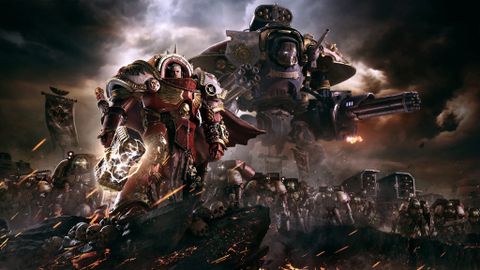Eight years after the last game, Warhammer 40,000: Dawn of War III finally arrived on Steam, bringing the science-fantasy real-time strategy (RTS) game into the modern era.
See on Green Man Gaming (Steam)
Three-way battle
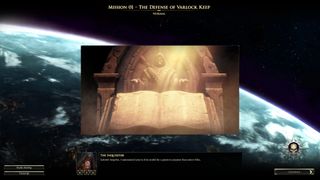
The Warhammer 40,000 universe is dystopian science-fantasy set approximately 40,000 years in the future. In this dark vision of things to come, humans have colonized millions of worlds. But the reigning government is the Imperium, a brutal theocratic regime. (How prescient!) The Imperium is in a perpetual state of war with several other species, its Space Marines fighting a never-ending series of battle for control of the universe.
Whereas Dawn of War II's campaign exclusively followed the adventures of the Space Marines (including a player-created character), the new campaign takes place from three different perspectives: Space Marines, the Cockney gangster-like Orks, and the elvish Eldar. All three races find themselves locked in a battle for the fate of a seemingly worthless planet. But that planet holds a dark secret that some would love to control.
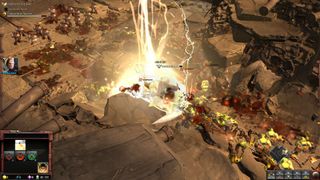
Levels alternate between each of the races, which is great for variety. But if you dislike one or two of the races, tough luck. You'll have to learn to use them effectively. The Space Marines are the all-around class and my personal favorite. The Orks can collect scrap from structures and vehicles they destroy, using it to power up and create new units. The Eldar have advanced shields that must be replenished, as well as gates that allow them to teleport between locations.
Meet the Elites
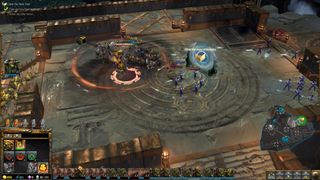
The role-playing aspects of the previous game's campaign are gone, so you won't be creating a character or equipping loot. But Elite units still provide a sense of character and greater control over the battlefield.
Each faction has its own Elite(s) with unique abilities, which naturally must cool down between uses. The Space Marines' first Elite can jump across the map or knock over everyone around him; the Orks' first Elite has a chain to use as a grappling hook or to spin around as both an attack and defensive measure; and the Eldars' initial Elite can throw and retrieve her spear.
Some of the later Elites get to pilot massive robots or monsters that tower over the battlefield, wreaking havoc. In the campaign, the game ends if your primary Elite bites the dust. But in multiplayer, they can be called in after a lengthy spawn timer counts down.
A strong traditional RTS campaign
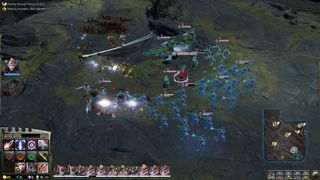
Besides the Elites, the gameplay generally works like any other RTS game. Each side must capture resource points that can then be mined for Requisition and Energy, the two primary resources. These resource points can be upgraded if you hold them long enough, as well as fortified with turrets.
All building construction is performed by builder units. They're not suited for battle, but they can make new buildings and repair structures and vehicles. Some of the buildings you'll whip up include Barracks for general unit production, upgrade structures that allow units to be upgraded and vehicle production facilities. It's all standard stuff, as are the controls for selecting units and grouping.

Although Dawn of War III is more of a traditional RTS than the last game, the campaign is still quite strong. The multiple perspectives make for an interesting story as you see how the sides encounter and bump against each other, with the Orks providing a humorous contrast to their overly serious counterparts.
The mission design is generally quite engaging. In one, the Orks have a gigantic cannon that flies across the battlefield whenever it's fired. They spend the mission charging it up and defending it, firing it, and then repeating until they can get the weapon back to their base. And an early Eldar mission involves destroying a series of Ork towers spread far across the map, all under the constant threat of enemy convoys. Each one is different and clever.
Missions can also be tough (even on casual difficulty), so make sure to save frequently. The apparent lack of quick save and quick load makes save management a bit of a chore, though. You have to name your save every time, and loading a save means loading back to the mission select screen before then loading into the mission itself. Hopefully Relic will streamline this process over time.
Multiplayer
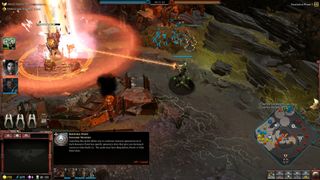
Dawn of War II's campaign co-op is nowhere to be found. Nor did the enjoyable Last Stand horde mode make the cut here. That means Dawn of War III launches with no cooperative modes at all – playing a versus game against an AI team doesn't count. I wouldn't be surprised if we get such a mode in a future update, but Last Stand should have at least been included by default.
Still, the series's popular competitive Skirmish mode should prove engaging to seasoned RTS players. Games can be one-on-one, two-on-two, or three-on-three. Playing with or against AI players is also an option. The game offers eight multiplayer maps at launch, with each restricted to different player counts.

The goal in Skirmish is to destroy the enemy's power core, a structure found within their base. To have any hope of doing that, you'll want to maintain control of as many resource points as possible. Forget about just building a ton of units right off the bat.
Resource production is slow enough that you can't pump out units en masse until you own several of the precious points. This can make for lopsided battles, because whichever side gets more points first has a significant advantage. Still, I sometimes managed to pull off a victory after a bad start. You just have to catch your opponent off guard.
Customizing your army
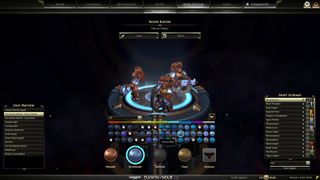
Upon completing campaign missions or multiplayer battles, you'll earn experience for the faction you used and a new resource called Skulls. These can be spent to unlock new Elite units and Doctrines. The latter are special abilities or modifiers that affect how an Elite unit plays.
Players can also customize the appearance of their units via the new Army Painting feature. This lets you select from each race's many unique teams and then change the individual colors of each unit on that team, as well as the team insignia. Given Warhammer 40,000's origins as a board game played with painted miniatures, Army Painting will likely appeal to longtime fans.
Dawn of connection issues

Unlike Dawn of War II, this game requires a constant internet connection to play – even in single-player. This is a form of copy protection – the same one Blizzard controversially implemented with StarCraft II. The connection requirement shouldn't be too much of a problem for most PC gamers. But it proved extremely inconvenient during the pre-release review window, as the servers kept going down. The servers probably won't shut down multiple times per day once the game is officially available. But that was my experience.
Even more annoyingly, the game does not save your progress when you lose connection to the server. Twice I had to restart a level because my connection got cut off on Sega's end. Hopefully the developers will implement autosaves or at least warnings when server maintenance occurs in the future. It seems they haven't considered player reaction to getting kicked out of the game.
Overall impression of Warhammer 40,000: Dawn of War III

The latest Dawn of War is a solid sequel to the beloved Dawn of War II. The campaign is interesting and varied, with three playable races and distinctive Elite units to control. The game looks fantastic, and the minimum system specs are surprisingly reasonable. My aging gaming notebook can run it, which was a pleasant surprise.
Not all of the changes here are for the better, though. The complete lack of cooperative multiplayer really stings, as campaign co-op and Last Stand were my favorite parts of the last game. And by beefing up the base building and resource management, Dawn of War III's gameplay doesn't stand out as much from other RTS games. Still, Warhammer 40,000 and strategy go together too well to let this one pass you by.
Dawn of War III is available exclusively on PC for $47.99.
Pros:
- You can play as all three factions in the massive single-player campaign.
- Elite units have unique personalities and abilities that make them fun to control.
- Excellent production values and reasonable system requirements.
Cons:
- Online connection is required even for single-player.
- There are no co-op modes, a step back from Dawn of War II's strong co-op support.
See on Green Man Gaming (Steam)
Steam review copy provided by the publisher.
Paul Acevedo is the Games Editor at Windows Central. A lifelong gamer, he has written about videogames for over 15 years and reviewed over 350 games for our site. Follow him on Twitter @PaulRAcevedo. Don’t hate. Appreciate!
